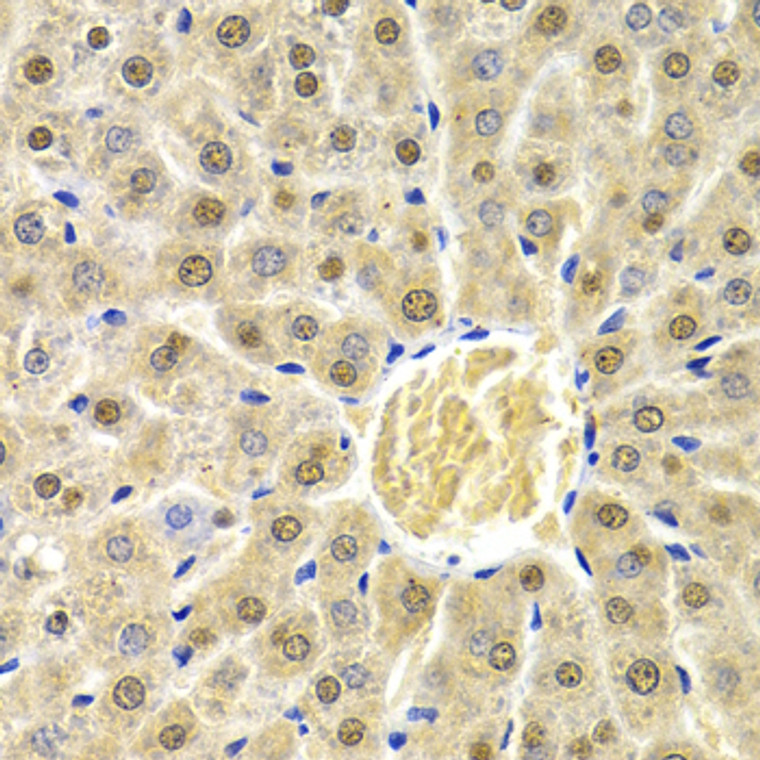| Host: |
Rabbit |
| Applications: |
WB/IHC |
| Reactivity: |
Human/Rat |
| Note: |
STRICTLY FOR FURTHER SCIENTIFIC RESEARCH USE ONLY (RUO). MUST NOT TO BE USED IN DIAGNOSTIC OR THERAPEUTIC APPLICATIONS. |
| Short Description: |
Rabbit polyclonal antibody anti-RAD9A (162-391) is suitable for use in Western Blot and Immunohistochemistry research applications. |
| Clonality: |
Polyclonal |
| Conjugation: |
Unconjugated |
| Isotype: |
IgG |
| Formulation: |
PBS with 0.02% Sodium Azide, 50% Glycerol, pH7.3. |
| Purification: |
Affinity purification |
| Dilution Range: |
WB 1:500-1:2000IHC-P 1:50-1:200 |
| Storage Instruction: |
Store at-20°C for up to 1 year from the date of receipt, and avoid repeat freeze-thaw cycles. |
| Gene Symbol: |
RAD9A |
| Gene ID: |
5883 |
| Uniprot ID: |
RAD9A_HUMAN |
| Immunogen Region: |
162-391 |
| Immunogen: |
Recombinant fusion protein containing a sequence corresponding to amino acids 162-391 of human RAD9A (NP_004575.1). |
| Immunogen Sequence: |
ALAEVTLGIGRGRRVILRSY HEEEADSTAKAMVTEMCLGE EDFQQLQAQEGVAITFCLKE FRGLLSFAESANLNLSIHFD APGRPAIFTIKDSLLDGHFV LATLSDTDSHSQDLGSPERH QPVPQLQAHSTPHPDDFAND DIDSYMIAMETTIGNEGSRV LPSISLSPGPQPPKSPGPHS EEEDEAEPSTVPGTPPPKKF RSLFFGSILAPVRSPQGPSP VLAEDSEGEG |
| Post Translational Modifications | Constitutively phosphorylated on serine and threonine amino acids in absence of DNA damage. Hyperphosphorylated by PRKCD and ABL1 upon DNA damage. Its phosphorylation by PRKCD may be required for the formation of the 9-1-1 complex. |
| Function | Component of the 9-1-1 cell-cycle checkpoint response complex that plays a major role in DNA repair. The 9-1-1 complex is recruited to DNA lesion upon damage by the RAD17-replication factor C (RFC) clamp loader complex. Acts then as a sliding clamp platform on DNA for several proteins involved in long-patch base excision repair (LP-BER). The 9-1-1 complex stimulates DNA polymerase beta (POLB) activity by increasing its affinity for the 3'-OH end of the primer-template and stabilizes POLB to those sites where LP-BER proceeds.endonuclease FEN1 cleavage activity on substrates with double, nick, or gap flaps of distinct sequences and lengths.and DNA ligase I (LIG1) on long-patch base excision repair substrates. The 9-1-1 complex is necessary for the recruitment of RHNO1 to sites of double-stranded breaks (DSB) occurring during the S phase. RAD9A possesses 3'->5' double stranded DNA exonuclease activity. Its phosphorylation by PRKCD may be required for the formation of the 9-1-1 complex. |
| Protein Name | Cell Cycle Checkpoint Control Protein Rad9aHrad9Dna Repair Exonuclease Rad9 Homolog A |
| Database Links | Reactome: R-HSA-176187Reactome: R-HSA-5685938Reactome: R-HSA-5693607Reactome: R-HSA-5693616Reactome: R-HSA-6804756Reactome: R-HSA-69473Reactome: R-HSA-9709570 |
| Cellular Localisation | Nucleus |
| Alternative Antibody Names | Anti-Cell Cycle Checkpoint Control Protein Rad9a antibodyAnti-Hrad9 antibodyAnti-Dna Repair Exonuclease Rad9 Homolog A antibodyAnti-RAD9A antibody |
Information sourced from Uniprot.org
12 months for antibodies. 6 months for ELISA Kits. Please see website T&Cs for further guidance









